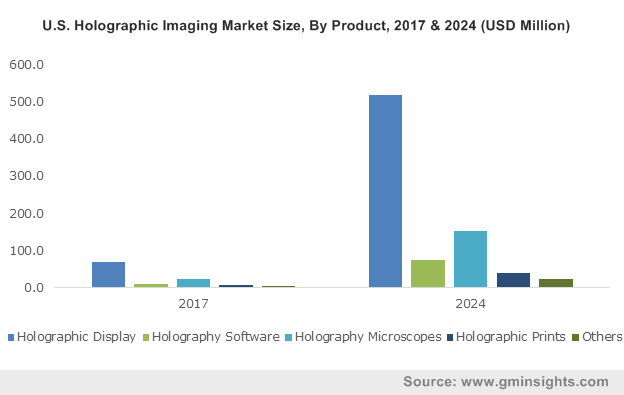Holographic imaging market Outlook
Germany holographic imaging market to witness a sharp growth curve over 2018-2024, escalating prevalence of bone disorders to underline the regional demand
With holograms on the verge of penetrating deeper into the medical fraternity, holographic imaging market is likely to experience a steep growth over the next few years. Many companies have been developing holographic technologies for biomedical imaging. For instance, Zebra Imaging, a renowned Texas-based holographic imaging industry player, has developed the ZScape Holographic Motion Display, a technology that is designed to produce true holograms.
U.S. Holographic Imaging Market Size, By Product, 2017 & 2024 (USD Million)

Through this technology, Zebra Imaging intends to prove that holography can substitute for the lack of cadavers in medical schools. The company has even partnered with the Zygote Media Group with an intention of getting this technology commercialized and deployed at major medical schools across the United States. Similar efforts by other companies, such as EchoPixel, RealView Imaging, and NanoLive is likely to propel holographic imaging market size, slated to cross a revenue of USD 2.5 billion by 2024.
Of late, the holography technology has been increasingly adopted by research institutions, surgeons, and biomedical scientists, pertaining to the fact that holograms allow doctors to undertake extensively minute colonoscopies virtually, eliminating the need of a physical testing procedure. They also help detect serious issues with sensitive organs such as the brain, the abnormalities of which are particularly difficult to interpret. In addition, the increasing prevalence of cardiovascular and neurological disorders among the growing global geriatric population will spur holographic imaging market trends.
Technological advancements that have taken place in holographic technology and the rising availability of medical devices for interpreting the holographic interferograms are certain to enhance the end-user landscape of holographic imaging industry. Subject to its high-grade interpretation techniques, this technology finds applications across hospitals and clinics, research organizations, pharma and biotech companies, and academic medical centers. Of these, irrefutably, hospitals and clinics are one of the most value-generating avenues for the industry. Apparently, hospitals and clinics held close to 28.9% of the revenue share in 2017. In the years ahead, holographic imaging market is expected to accrue substantial proceeds from hospitals and clinics owing to the rising adoption of these devices on disease detection. Indeed, in recent times, endoscopic holography has come to be extensively utilized across hospitals given that it is a powerful tool for high nondestructive, non-contact measurements and resolution imaging in human internal organs.
Get a Sample Copy of this Report @ https://www.gminsights.com/request-sample/detail/1648
Large-scale corporations operating in holographic imaging industry engage in novel product launches coupled with the deployment of the latest technologies, to stay ahead of their rivals. Toward the end of 2016, renowned holographic imaging market player Holoxica had launched a holographic 3D digital human anatomy atlas prototype, that has given clinicians and neuroscience medical experts an insight into the detection, diagnosis, and treatment of neurological disorders. Notable participants of holographic imaging industry include NanoLive, Mach7 Technologies, Holoxica, RealView Imaging, Echopixel, and Ozivio Imaging Systems.
Holographic imaging industry is in the process of strongly establishing its footprints across the globe. Geographically, Germany is touted to be one of the most proactive regional contenders of holographic imaging market. Pertaining to the extensive awareness regarding the availability of technologically advanced products, Germany holographic imaging market is anticipated to record a commendable double-digit CAGR of 33.3% over 2018-2024. The region will also experience substantial growth on account of the rising prevalence of orthopedic disorders such as rheumatoid arthritis in Germany that will help escalate the demand for X-ray holographic imaging systems.
While holography, as a technology, has found widespread popularity and is a subject of research for scientists, its deployment as a full-fledged technique will face complications. This is primarily due to the high implementation costs and the lack of convenient accessibility. In addition, the existing holographic display technique has poor spatial resolution. These constraints can be overcome as more and more companies are coming up with highly advanced and cost-effective technologies, thereby propelling global holographic imaging market.
Author Name : Saipriya Iyer
